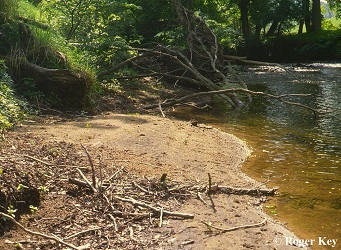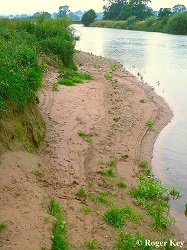Current ISIS code: W122
Previous assemblage name: W122 Riparian sand & W124 soft rock seepage.
Linked assemblage: W111 shingle bank.
Description of habitat typically supporting the assemblage: This wide ranging SAT occupies a range of habitats from the tail end of shingle banks supporting W111 assemblages to purer banks of sand and silt on slow flowing rivers and the margins of seepages on soft-rock cliffs, but there would be appear to be little benefit in dividing it up. It also overlaps with assemblages found on sand in coastal areas that include species coded to the M2 BAT. As with W111 assemblages, this SAT is dependent on repeated turnover of sediment by spates. On soft rock cliffs, it depends on landslips to create areas of bare or sparsely vegetated damp sediment. It is therefore sensitive to management of river channels and catchments, changes in rainfall patterns and coastal erosion. The larvae of many species are probably thermophilic, so it may also respond to temperature rise.

The assemblage type is found on soft, bare or sparsely vegetated exposed riverine sediments ranging from fine sand mixed with silt to coarse sand mixed with cobbles. It also occurs on eroded sections of bank, especially in areas of slumped sand and clay and by spring-fed seepages of water on coastal soft rock cliffs.

In riparian areas, assemblages depend on erosion and deposition of sediment by annual periods of high flow, while on soft rock cliffs they benefit from the large scale disturbance provided by landslips, which create extensive areas of bare ground for breeding habitat. Elements of this assemblage type also occur on the sandy edges of large lakes and in artificially disturbed sites such as quarries, sand pits and gravel pits, but only in their early stages of vegetation succession.
Adults exhibit a variety of morphological adaptations related to living on or in bare substrates. Larvae are presumed to be terrestrial and to require insolation of their habitat to aid development. Climate change can be expected to affect this assemblage type through increased temperatures, changes in rainfall patterns and coastal erosion.
Links to other conservation objectives: Climate change (rainfall, temperature, coastal erosion), river management.
Sampling & assessing the assemblage
Standard sampling protocols apply.
Target groups: Coleoptera.
Fieldwork methods: Ground-searching.
Alternative methods: Passive trap methods.
Season: Mid May-late June for beetles.
Repeated surveys on the River Soar in Leicestershire have detected annual variations in the SAT score that may reflect fluctuating populations in a naturally unstable environment. This suggests that holding firmly to a species score may not necessarily reflect condition, and quality and fidelity of species may be as important as count in that decision. There are diptera with high fidelity associations here, though they are hand coded and not part of the original ordination.
Discrimination of conservation quality: good
Default target: 5 species
